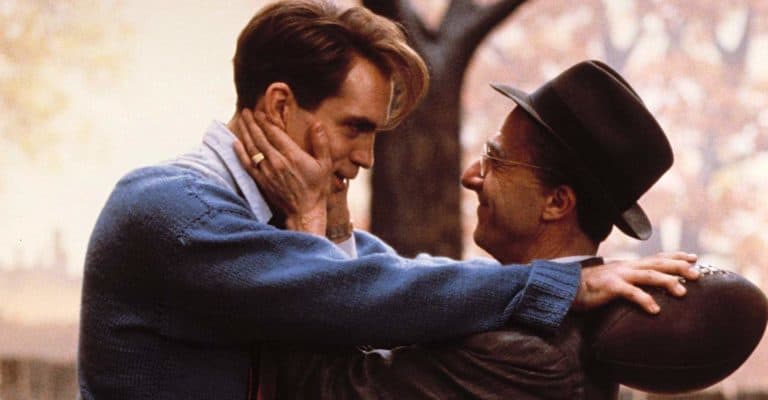In an article entitled The Family in Modern Drama, Arthur Miller insisted that all “great plays” finally grapple with one central issue: “How may a man make of the outside world a home?”.
Making the outside world a home would imply being “well-liked”: managing to turn anonymous, business relations into close family ties – that is to say being able, like Dave Singleman, “to go… into twenty or thirty different cities, and pick up a phone, and be remembered and loved and helped by so many different people?” (p.63).
In Death of a Salesman, the dream of social success cannot be disentangled from the idyllic vision of society as a large, tightly-knit family.
Yet, there is every reason to believe that Dave Singleman, as his patronymic shows, is a bachelor, when the foundation of the much-vaunted American ideal remains the nuclear family: the nuclear family as an agent of socialization and as a stabilizing influence.
Precisely in Death of a Salesman spectators are given privileged access into the private sphere of a family and occasionally turned into voyeurs. It seems that far from offering a secure, reassuring nest the family also reverberates the tensions of society at large in the 1950s.
1. The Green World patriarchal clan
Willy, through his conversation with Ben (38-41) harks back to his infancy. The image of the father is mythologized by both sons – the elder Ben and the younger Willy – even if Father Loman deserted his wife and children to lead an adventurous life.
The mother is hardly ever referred to. She must nevertheless have had a hard life providing sustenance and comfort for her two sons. When Ben followed in his father’s footsteps by running off for adventure, Mother Loman still had Willy to look after.
Willy, who recalls sitting on “Mamma’s lap” (38), suffered from his father’s absence. The lack of paternal care resulted in his feeling “kind of temporary about (himself)” (40).
Mother Loman’s caring presence is trivialized: “fine specimen of a Lady, Mother” (35) and the “old girl” when reunion with the vanished father is Ben and Willy’s single purpose. Ben starts for Alaska hoping to find his father (37) and Willy elects a father figure through his total devotion to Dave Singleman, another salesman.
Willy has remained so obsessed with the myth of his Father that he entreats Ben to tell Biff and Happy about their grandfather, so they can learn “the kind of stock they spring from” (38). So, in a way, it is as if all the Loman men sprang directly from their father’s side and as if their mother had had no part to play in their birth.
An Edenic myth is implied which seems to preclude, or at least downplay woman’s role in the procreation process.
2. The future of the family model
In Death of a Salesman, it is suggested that the family model has outlived the Green World (the pioneering days) and adapted to the Business World and that its future is bright, even if women are bound to remain on the fringe, on the periphery.
After all, Howard’s wife appears only in the shape of a canned, recorded voice and Bernard never shows up.
Yet, being unmarried implies being unsettled and drifting purposelessly. Biff is aware of his deficiency, he lacks substance, and he is not fully mature: “I’m mixed up very bad. Maybe I oughta get married. I’m like a boy. I’m not married, I’m not in business, I just – I’m like a boy”. (17)
Happy, for his part, keeps repeating that he is about to get married as if it was the thing to do to please his parents and especially Willy: “I’m gonna get married, Mom. I wanted to tell you.” (53). “I’m getting married Pop, don’t forget it” (106).
Social success and personal achievement involve getting married. Howard is married and has two children and even anaemic Bernard, on top of being a successful lawyer, is married with “two boys” (72).
The nuclear family is the norm, the valued model, the ideal that the Loman brothers for all their claims to independence and philandering wish to emulate.
3. The collapse of the Lomans
Something must have gone wrong because somehow the Lomans do not succeed as a family, even if they fit in with the common norm: two parents/two children.
The Loman family disintegrates.
Loman violates the family’s sanctity through his sexual misdemeanour. Biff’s traumatic discovery of his father’s adultery splinters the father/son relationship irreversibly.
Happy flies from the family nest to set up his apartment and enjoy his women. Sex proves a divisive force among the Lomans, separating parents from each other and parents from sons. Happy goes as far as denying Willy as a father in the restaurant scene: “No, that’s not my father. He’s just a guy.” (91)
Robert D. Hess and Gerald Handel, in an article entitled The Family as a Psychosocial Organisation, have shown that separateness and connectedness are the underlying conditions of a family’s life.
In Death of a Salesman, the family reunion which takes place is an explosive one. As in All My Sons, After the Fall or The Price, bringing members of the family together only makes their fundamental separateness explicit and irrevocable.
Attempts to recreate family unity, like Ben’s offer of partnership; Biff’s return home or the brothers’ schemes to go into business together have a twofold consequence: they shed light on hidden sources of conflict and they alienate family members from each other.
It is the big dinner, almost at the end of the play, which seals the family’s implosion process. The cacophony of their dissonant motives bursts in this restaurant room and the centripetal forces of their separate lives triumph over the need for unity that first motivated the decision of having dinner at Frank Chop’s House.
